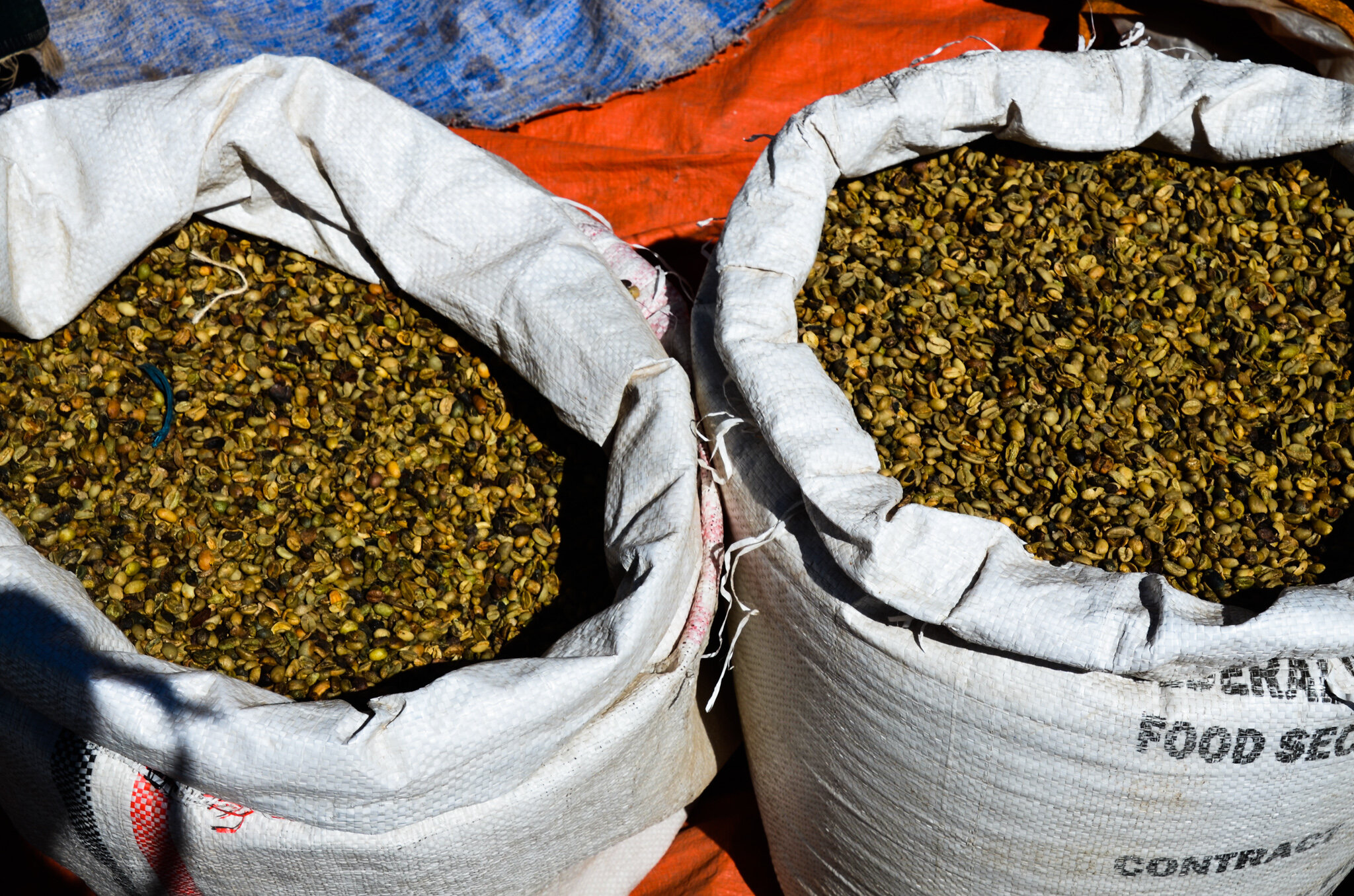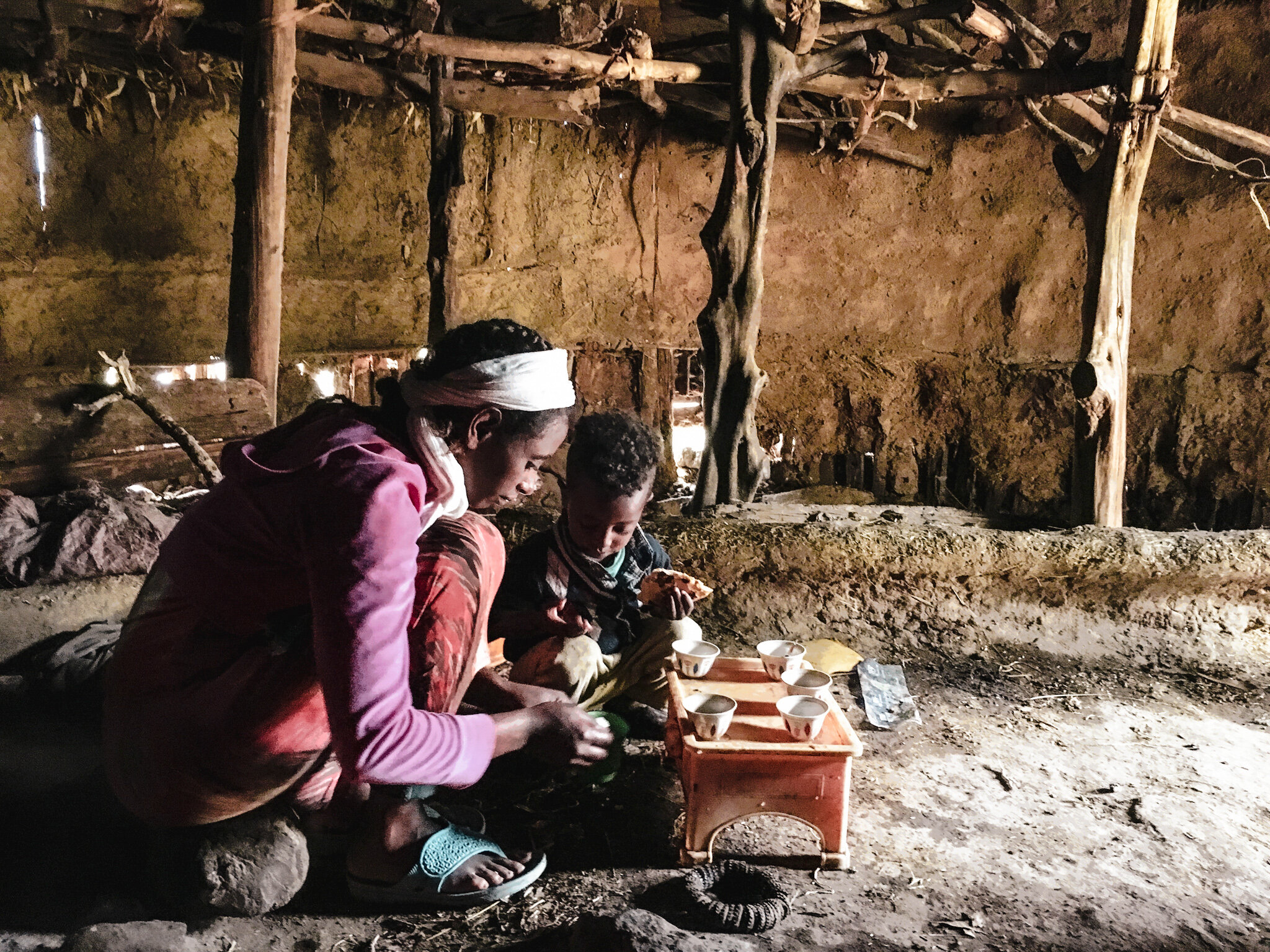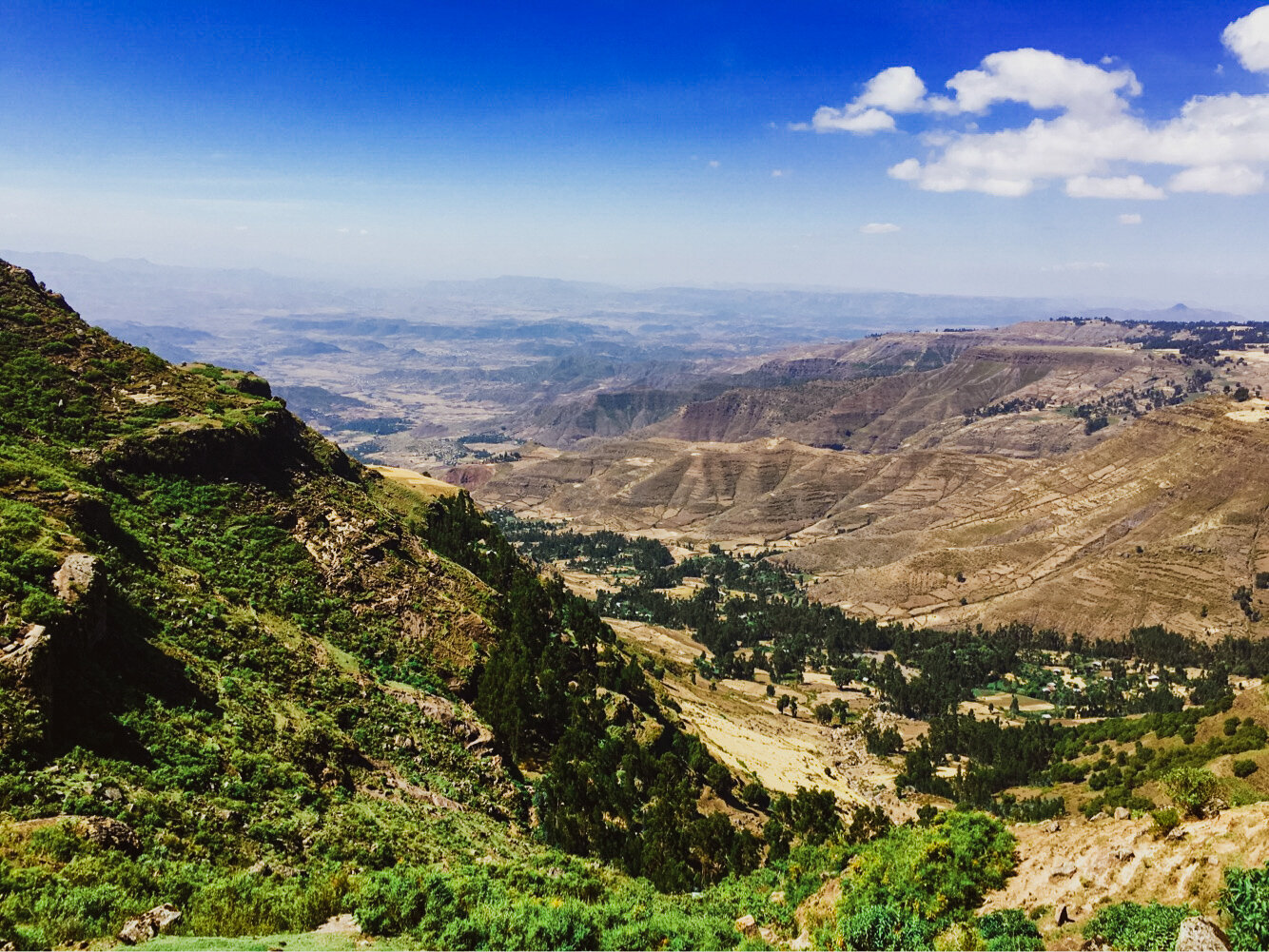In Ethiopia, ‘Coffee Is Our Bread’
Text and Photos by Alicia Erickson
Unroasted coffee beans are offered for sale in Lalibela.
“Buna?” the elderly Ethiopian woman prompts, as she motions me into her dimly illuminated thatched home. Sharing coffee with strangers, friends, and family is an age-old tradition in Ethiopia, and one that I was invited to partake in almost daily during my time in the country.
History
According to legend, coffee was first discovered in Ethiopia as far back as the 9th century by Kaldi, an Abyssinian goat herder. Kaldi had been herding his goats in the highlands near a monastery when the herd began behaving strangely. They started jumping around and became so energetic that they did not sleep at night. Kaldi soon discovered that his goats had been eating red berries from a tree. Out of curiosity, he decided to try them for himself, and like his goats, he felt an energizing rush from the berries.
Kaldi headed to the monastery to share his discovery. Skeptical of the berries, one monk claimed that they were the work of the devil and threw them into a fire. Upon throwing them into the fire, the roasting beans emitted an aroma so enticing that the monk realized his mistake and kept the beans in a jug with hot water to preserve them. The monks later drank the brew, which they discovered helped them to stay awake during their nightly prayers.
Many variations of this tale exist. However, what is indisputable is that Ethiopians take deep pride in the role their country plays in the history of coffee. The tradition of drinking coffee in Ethiopia dates back centuries and continues to be a central part of Ethiopian culture today. Coffee is as important as wine is in France and tea is in India. There is an Ethiopian saying, “Buna dabo naw,” that literally translates to “Coffee is our bread.”
After spending a few weeks exploring Ethiopia, I began to understand why it is one of the largest consumers of coffee on the African continent. From street stands in bustling Addis Ababa, to the humble abode of a tukul in Amhara’s mountains, coffee in this landlocked nation on the Horn of Africa is an abundant and treasured commodity.
Addis Ababa: an introduction to Ethiopian coffee
Upon arriving in Addis Ababa, I set out to explore the city. As I walk up and down main streets and wander down narrow alleyways, I am struck by the abundance of street food and coffee stands. This was a rarity in Kigali, the quiet capital of Rwanda, where I had been living for over a year. About every second business in Addis Ababa is a coffee shop, and each time I peek my head inside, I am promptly invited in for a cup of coffee.
“Come, come inside! You know we are famous for coffee in Ethiopia?” a young woman asks as she waves me into her shop.
With little hesitation, I step into a small, corner café that serves one item only: coffee. I sit down on one of the few seats in the café while a pot is being prepared. Before long, I am presented with a petit cup of freshly brewed coffee. I inhale the rich, earthy scent, one familiar to my nose but not my taste buds.
So intrigued by the infamous Ethiopian coffee, I momentarily forgot about my inexplicable caffeine intolerance, which has more or less prevented me from drinking coffee for most of my life. I carefully sip the aromatic, steaming liquid, savoring the foreign taste on my palate. The taste, which perfectly matched the scent, has a subtle hint of chocolate. The tiny cup of potent coffee was worth the sleepless night that followed.
Ethiopian Coffee Industry
As the largest coffee producer in Africa and the fifth largest in the world, Ethiopia harvested approximately 600,000 tons of coffee during the 2019/2020 production years. The majority of coffee plantations are small, private plantations, the rest being large state-owned farms. With an improved production and marketing system, as well as enhanced infrastructure and technology, Ethiopia aims to triple its coffee production over the next five years, with the goal of harvesting 1.8 million tons by 2024. Coffee is the most important export in Ethiopia, accounting for 34% of the value of all exports in 2017/2018. Europe, Japan, and the United States are the largest importers of Ethiopian coffee.
Today, more than 12 million people in Ethiopia work in the coffee industry and are involved in everything from the cultivation of coffee to the picking of the fruit. The main coffee growing regions are in Harar, Ghimbi and Sidamo, where 95% of the coffee is grown by small land holder farmers.
Harar coffee is grown on small farms in the eastern part of the country and are dry processed. These beans, which are full bodied with notes of blueberries and blackberries, are best used in espresso blends to fully capture their rich, aromatic nature.
Coffee beans grown in Ghimbi and Sidamo, in the west and the south of Ethiopia respectively, are washed as opposed to dry processed. Ghimbi beans are heavier than Harar’s, while Sidamo’s beans, also known as Yirgacheffe coffee, are milder and fruitier in flavor and are typically the most favored of Ethiopia’s coffee beans.
Ethiopian coffee isn’t just for export, though. With a significant coffee-consuming culture, almost 50% of Ethiopia’s coffee is consumed locally. This isn’t always true among many coffee producing nations and countries with similarly developing economies, many of which export their best beans for profit rather than keep them for local consumption.
Mariam and her grandson roast coffee in the tukul.
From Addis to the Amhara Highlands
By my second week in Ethiopia, I had landed in the highlands of the Amhara region. Situated among expansive rocky plateaus above the ancient holy city of Lalibela, this remote region is only accessible by foot or donkey. The scattered villages primarily exist as pastoral communities, removed from the electric grid. The round, mud tukul huts and the food traditions of spice-forward stews and injera cooked over an open fire have been iconic to the region for over a thousand years, dating as far back in time as the story of Kaldi the goat herder and the coffee beans.
After a long day of hiking through the open expanse of the mountains, I found myself in a small village sparsely dotted with tukul structures. My local guide, Rasta, stopped to greet a tall, older woman dressed in a long, blue-flowered skirt standing in front of her home. “Selam!” she grabbed my hand in hers as a smile reflected in her eyes. “Mariam,” she introduced herself, touching her chest, and welcomed us into her home.
I stooped down to enter Mariam’s tukul. The hut’s only opening aside from the door was a hole at the top of the roof to allow smoke to escape. A slim stream of sunlight beamed in through the narrow vent. My eyes worked to adjust to the dark, smoky room. The family’s cows and goats were sleeping in their divided section of the home.
A fire blazed in a pit in the center of the home. Mariam, her husband, their two daughters and their two grandsons sat around the fire. Introductions were made through a combination of gestures, Rasta’s translations and me stumbling over a handful of Amharic words. Almost immediately, Mariam motioned to an elegant coffee pot, inviting me to partake in an Ethiopian coffee ceremony.
A tukul with a view in Amhara.
Coffee Ceremony
Ethiopia’s special relationship with coffee is most apparent in its traditional coffee ceremonies, or jebena buna. Not for those in a hurry or looking for a quick caffeine fix, jebena buna are famously long and rich in detail. The ceremonial process is an art, reminding one to slow down, savor the process and reconnect with friends and family.
To initiate the ceremony, Mariam lights a small plate of chipped incense. The warm, velvety, aromatic plumes of frankincense cut through the sharp odor of manure and farm animals. Next, Mariam opens a canister and washes the raw, tan-hued beans thoroughly before pouring them onto a wide, shallow metal pan over the open fire. She motions for me to come over and entrusts me with the job of roasting the beans. I carefully turn them over the crackling flames. The heat gradually darkens their skins, awakening a rich, chocolaty scent.
After the beans are black and charred, I pour them into a mortar and pestle. With force, Mariam grinds the beans into a fine dust and mixes the powder with water in a jebena—an elegant spouted pot specifically for coffee—and places the pot back onto the fire. While the liquid is heating, Mariam pours the coffee out of the jebena and back in again and places the pot back onto the fire. She repeats this process three times over to filter the liquid. By now, the earthy scent of the coffee has entangled with the incense, creating an intoxicating smoke that fills the room.
Each stage of the coffee preparation is executed with intention. There is an intricacy that went into each step of the process, a care that is lost in the era of instant coffee. At long last, Mariam’s daughter pours the coffee in a long stream into tiny cups. She adds a dash of salt—coffee with salt is a specialty in Northern Ethiopia—and passes the cups around the room.
Due to my inexplicably bizarre intolerance to caffeine that left me with a sleepless night in Addis and often with much worse side effects, I am hesitant to drink much. The potency in this deceptively small portion is a mystery. However, when offered coffee in the northern highlands of Ethiopia, it is impossible to refuse.
I tentatively sip the thick liquid, more bitter than the coffee I tasted in Addis, further accentuated by the salty aftertaste. And yet there is something subtly enjoyable about it, perhaps made that much more enticing by the company and the atmosphere.
“Do other countries you visit in Africa also drink coffee?” Rasta inquires, while we sip on our cups.
I hesitate to answer. Coffee simply is not part of the culture in most of East Africa, such as Rwanda and Tanzania, where I have previously lived. Although coffee is a major crop and part of the economy in these countries, the best crops are exported, and the staple cup, if there even is any, is typically made from instant coffee. Ethiopia drinks an exceptionally high percentage of coffee in comparison to other coffee exporting countries with similar economies.
“Nowhere drinks coffee quite like Ethiopia,” I answer, while finishing my cup. Mariam’s daughter immediately refills my cup before I have an opportunity to refuse. An empty cup or plate signals wanting more, which I carelessly forgot in my mission to simply finish one serving.
“Coffee is a way to connect with family,” Rasta explains. “Even today, which is a day of rest, people still make coffee. Sometimes, families drink it as many as three times a day.”
Mariam and her family continue to drink more coffee, lingering over their cups. My second cup turns into a third and soon, fresh bread baked over the fire, stew and plastic jugs of sorghum beer are being passed around. There is no hurry nor is there anywhere else to be. Everyone is where they belong: sharing coffee, breaking bread and exchanging stories with friends old and new.



